The following observations were made in the Alpine village of Bellcombe and the outlying hamlet of Brossieux, Savoie France.
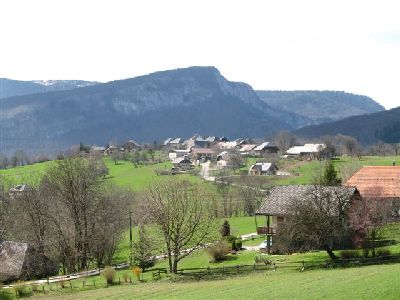
Brossieux seen from Bellcombe.
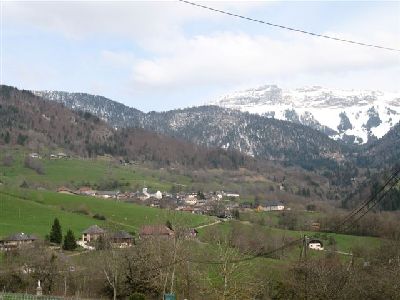
Bellcombe seen from Brossieux.
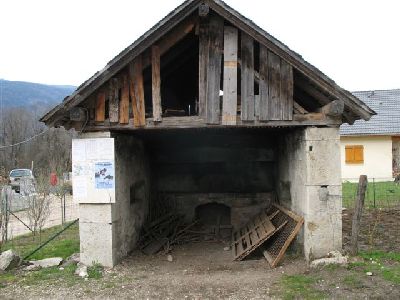
The community bake house in the hamlet of Broissieux, Savoie France.
The below information was recounted by an 80 year old man who has lived opposite the oven all his life.
The oven its self was re built in 1941 in the hamlets original bake house, which is about 150 years old. All occupants of the Hamlet worked voluntarily on the construction, and money was collected to pay for the prefabricated elements of the bake chamber and the specialist who was brought in to construct the vault.
The below information was recounted by an 80 year old man who has lived opposite the oven all his life.
The oven its self was re built in 1941 in the hamlets original bake house, which is about 150 years old. All occupants of the Hamlet worked voluntarily on the construction, and money was collected to pay for the prefabricated elements of the bake chamber and the specialist who was brought in to construct the vault.
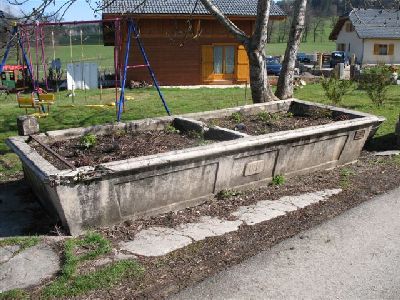
One of two community wash troughs in Brossiex now used as flower pots.
Though once the nuceus of communal life, the wash troughs, like the oven,
are now little more than romantic village ornaments.
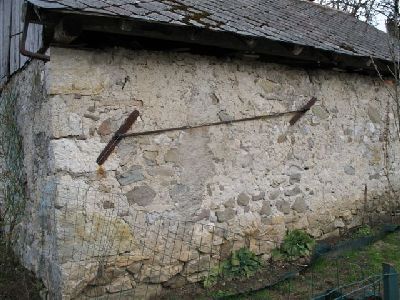
Iron tie bars traverse the bake house from side to side, retaining the lateral throw of the ovens vault.
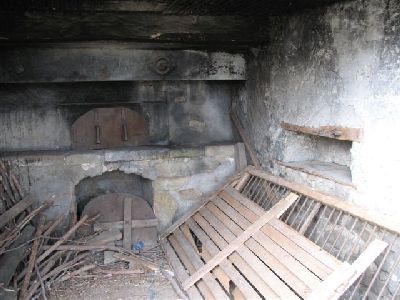
The oven was fired every two weeks in winter and every third week in Summer
The villagers would take turns at firing, each bringing their own faggots and firing for their own bake loads. Those who fired it first from cold would need about 12 to 15 faggots and have to wait half a day for it to achieve operational temperature. Those using it last at the end of the second day of baking, needed only two faggots. Those who used it first on one occasion would use it last the next time.
Ashes were equally divided amongst the inhabitants, and used as fertiliser.
The villagers would take turns at firing, each bringing their own faggots and firing for their own bake loads. Those who fired it first from cold would need about 12 to 15 faggots and have to wait half a day for it to achieve operational temperature. Those using it last at the end of the second day of baking, needed only two faggots. Those who used it first on one occasion would use it last the next time.
Ashes were equally divided amongst the inhabitants, and used as fertiliser.
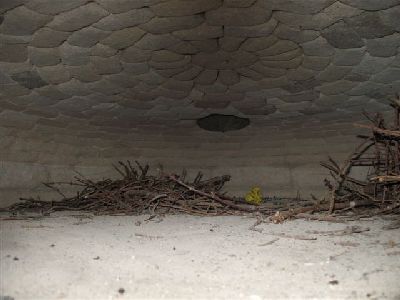
The vault is formed from refractory brick of several different formats,
bought by the hamlet as a semi prefabricated kit that was assembled by an expert.
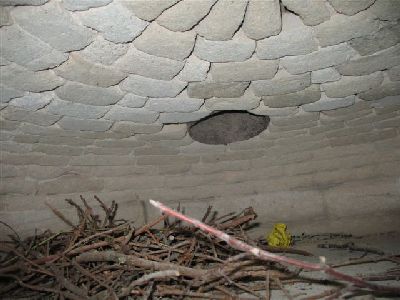
The round flue at the back of the bake chamber is the principal outlet of the
gasses, and leads into a masonry flue that passes over the outside of the vault
and feeds back into the avaloir above the loading opening. This helped reduce
time taken to reach operating temperature and could be used to reduce temperature
during baking, without opening the door.

The steel door originally slid to the left, when opened, on a steel rail affixed to the facing.
The operating handle top right controls the draw through the exit flue in the back of the vault.
The flue feeds into the avaloir through the square opening in the face behind, below and slightly left of the operating handle.
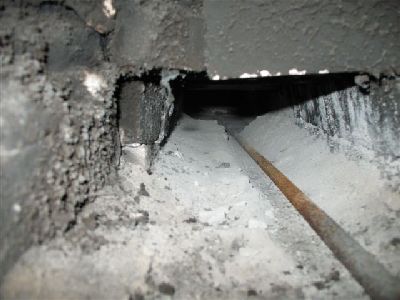
The flue leading from the exit opening, over the vault to the avaloire.
The rod connects the operating handle to a shut off damper over the exit opening in the vault.
The flue runs through 50 cm of sand and clay which covers the vault.
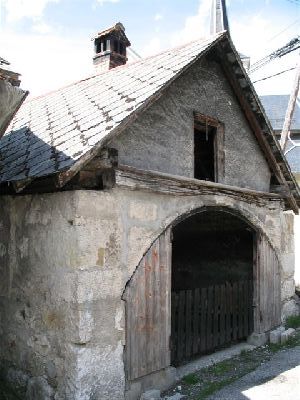
The Bake house in Bellecombe.
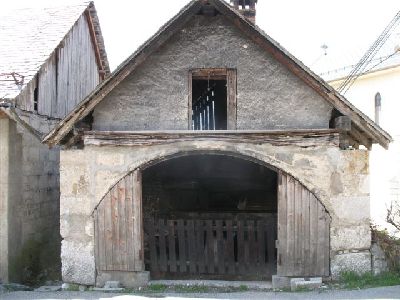
Like the bake house in Brossieux, the structure seen here is at least 150 years old.
The oven its self though was rebuilt, apparently some time before the rebuilding of the Brossieux oven.
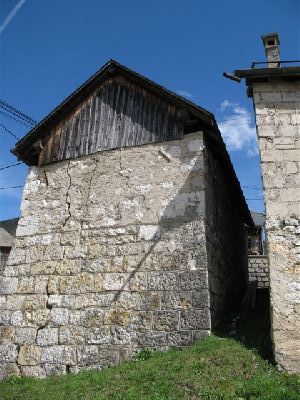
The bakehouse seen from the road behind.
Note the vertical cracks in the masonry.
Note the vertical cracks in the masonry.

The interior of the bakehouse.
Note the barely visible iron retaining shield below the ovens loading opening, behind the two logs in the foreground. This served to keep the hot embers, removed from the bake chamber, away from the feet of the operator.
This oven is now only fired once a year during the village festival.
The wood load consists exclusively of faggots.
Note the barely visible iron retaining shield below the ovens loading opening, behind the two logs in the foreground. This served to keep the hot embers, removed from the bake chamber, away from the feet of the operator.
This oven is now only fired once a year during the village festival.
The wood load consists exclusively of faggots.
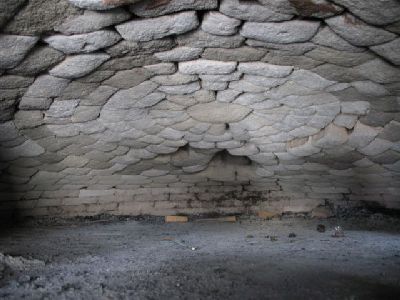
Though in worse condition than the Brossieux oven, the vault is of essentially
the same construction, being made from several formats of refractory brick.
Like the Brossieux oven there is also a flue exiting the rear of the vault,
traversing the mass on the outside of the vault, and feeding into the avaloire.
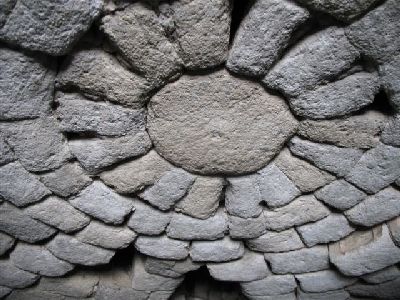
The refractory brick vault. No reliable information was available concerning the
origins of these specially formed moduls, though slightly different to the Brossieux
oven's vault, and said to be earlier, the materials look to be from the same source.
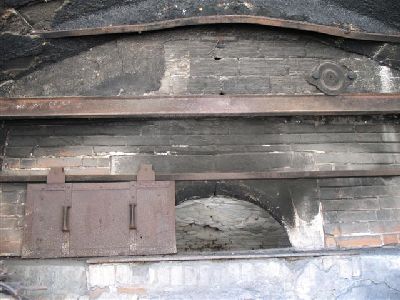
The facade of the oven. The operating handle (top right) for the flue is of
exactly the same fabrication as the one in Brossieux.
The toggle chain (top centre) opens the avaloire by raising a piece of flat metal that is attached to a hinge on the inside of the front of the avaloire.
The toggle chain (top centre) opens the avaloire by raising a piece of flat metal that is attached to a hinge on the inside of the front of the avaloire.
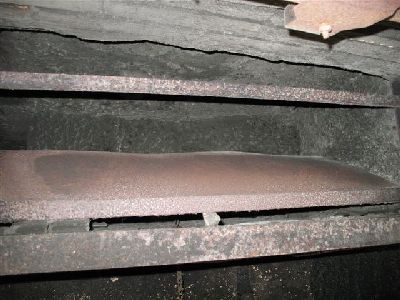
View up the avaloire, showing its shut off plate in the open position. The iron
bar keeps the hinged shut of plate in position when closed.
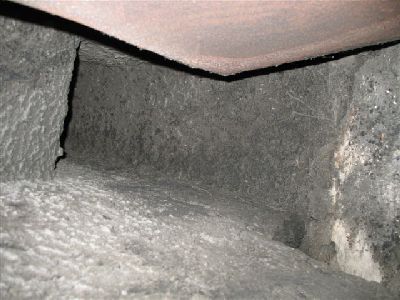
The rectangular flue, (at middle left), inside the avaloire, and the corner
of the avaloirs shut off plate, at top.
When the shut off plate, which is seen here in the open position, is closed, the oven is forced to draw exclusively through the over vault flue way.
There was no evidence of there ever having been a shut off plate in the Brossieux ovens avaloire.
When the shut off plate, which is seen here in the open position, is closed, the oven is forced to draw exclusively through the over vault flue way.
There was no evidence of there ever having been a shut off plate in the Brossieux ovens avaloire.
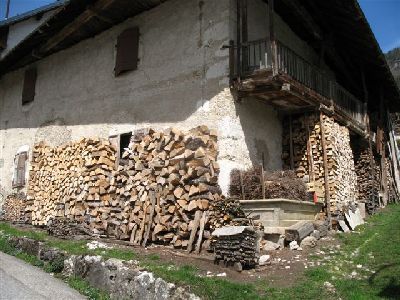
This dwelling in Bellecombe still has an operational cookstove and domestic oven, as well as a standard RWA.
Like all inhabitants of the village the occupant knows how to season and store wood.
Note the Faggots stacked on top of the wash trough.
A couple who moved into the village recently, were firmly informed by the local wood dealer that he would not deliver more wood if he saw them storing it outside, unprotected from the elements.
Like all inhabitants of the village the occupant knows how to season and store wood.
Note the Faggots stacked on top of the wash trough.
A couple who moved into the village recently, were firmly informed by the local wood dealer that he would not deliver more wood if he saw them storing it outside, unprotected from the elements.
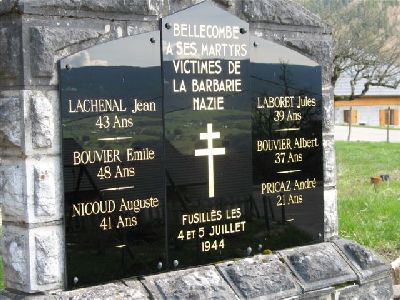
The villager living opposite the oven in Brossieux, as a 14 year old boy witnessed
a thousand fascist troops enter Bellecombe in 1944.
Looking for the Marquis. They executed Jules Laboret, Emile Bouvier, Jean Lachenal,
August Nicould, Andre Pricaz, and Albert Bouvier. And tortured several others.
Though the details of his account are too horrific to describe in this article,
it should be noted that these Fascists were not all Germans.
